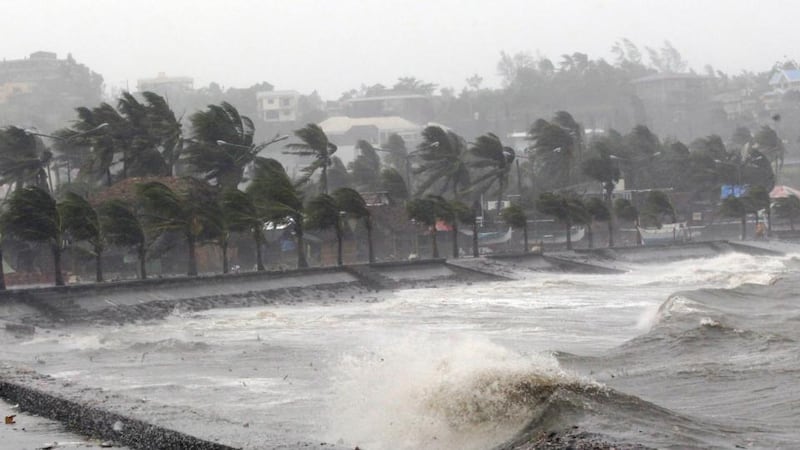A powerful typhoon tore through the central Philippines on Sunday, bringing howling winds that toppled trees and power poles and cut off communications in areas where thousands were killed by a massive storm just over a year ago.
More than one million people had fled to shelters away from coastal areas and landslide-prone villages by the time Typhoon Hagupit made landfall on Saturday night, in what a UN agency said was one of the world’s biggest peacetime evacuations.
Hagupit, which days earlier had reached category 5 “super typhoon” strength as it churned across the Pacific Ocean, further weakened on Sunday to category 2 as it made a second landfall at Cataingan town in the south of Masbate island.

“We are now experiencing very strong winds and heavy rains,” Wilton Co, mayor of Cataingan town, told a radio interview. “I asked everyone to stay indoors and move inland to higher ground, hoping that we will have zero casualties.”
The typhoon was moving west northwest at 15km/h, with sustained winds of 140km/h (86mph) and gusts of up to 170km/h (105mph), the Philippine weather bureau PAGASA said. It was expected to pass around 120km south of the capital Manila by early Monday morning.
Power was cut across most of the eastern island of Samar and nearby Leyte province, including Tacloban City, considered ground zero of the devastating super typhoon Haiyan last year.
“I can’t penetrate the areas, I can’t go north or south because of fallen trees and power lines. Many areas are flooded,” Ben Evardone, congressman for Eastern Samar, said from his base in the provincial capital Borongan.
Local radio reported at least four people were killed in Eastern Samar and Iloilo, but that could not be confirmed by officials. The Philippine Red Cross said it was also verifying the reports.
Alexander Pama, head of the disaster agency, said major roads in parts of Samar and Leyte islands and the south of the main island Luzon were not passable due to debris, and some areas were also flooded.
General Gregorio Catapang, head of the military, said nearly 2,000 soldiers were clearing the roads and two airports on Samar to bring in food trucks and aircraft loaded with emergency supplies.
“There were areas that experienced storm surges,” said Science and Technology Secretary Mario Montejo, adding the agency was verifying the exact height of the waves.
The weather bureau said Hagupit - which means “lash” in Filipino - was maintaining the projected path that would take it through Masbate, Romblon and Mindoro islands in the archipelago’s central belt, slightly north of areas devastated by super typhoon Haiyan last year.
Low-lying villages and landslide-prone areas had been evacuated, with residents taking shelter in schools, civic centres, town halls, gyms and churches, the national disaster agency said.
Alfred Romnualdez, mayor of Tacloban, said although more than 48,000 had fled to shelters, damage to the city appeared to have been minor.
“Thank God, the typhoon spared us and we have no reported casualties,” Mr Romualdez said. “By the end of the day we expect the people to return to their homes from shelter areas.”
There were more than 1.2 million people crowding over 1,500 evacuation centres across the central Philippines, said Gwendolyn Pang, secretary general of the Philippine Red Cross, adding local governments were providing the evacuees’ basic needs.
But there were worries on sanitation and the impact on health of the evacuees in cramped spaces especially in urban areas.
“The critical issue is in evacuation centres where there is a high number of evacuees,” said Social Work Secretary Corazon Soliman. “We are concerned that the congestion will cause more threat on health.”
Environment and humanitarian groups are hoping the typhoon would spur action at UN climate talks in Lima, where almost 200 nations are meeting to work out an accord to slow global warming, due at a summit in Paris in a year’s time.
"My country is under water, farms have been wiped away, homes destroyed, families separated," Shubert Ciencia of the Philippine Rural Reconstruction Movement and a member of global relief organisation Oxfam, said in Lima.
“Nobody should have to live under the threat of destruction year after year. But we want action, not pity. Negotiators have a chance to make history by standing up for those who have already lost so much and the millions more who will suffer the same fate unless we act now.”
An Oxfam report in November showed Asia is highly vulnerable to increasingly severe and frequent weather extremes and woefully underprepared to manage growing crises.
Reuters
















